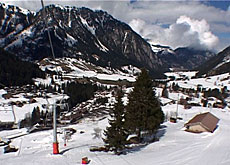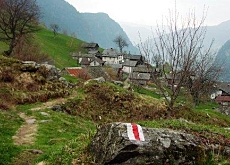An invitation to live in paradise

An alpine village has taken the unusual step of using its tourism website to appeal for new residents, who are needed to ensure the survival of its school.
swissinfo visits Schwenden, a bucolic village in the heart of the Bernese Alps. It’s far from the madding crowds but its population is slowly dying out.
“Restaurant” and “bakery” can still be clearly read on the side of the largest building in the village centre.
“It was quite a big restaurant 20 years ago,” remembers Roland Marti, schoolteacher and head of the committee to save Schwenden.
“The owners first closed the restaurant, then their shop and bakery. They ran a small café here for the past couple of years but they’ve closed that now too to make way for apartments they’ll rent out to tourists.”
Besides the ski lift and a few farms, there is one tiny grocery store remaining in Schwenden as well as a garage and two carpentry shops. In total, employment for about 10 people in the 270-soul community, he says.
Still, Marti believes the quality of life here is much higher than in Switzerland’s cities or towns, on the condition that the villagers can keep the school open.
That is why he and about ten other residents formed the committee and issued the appeal to outsiders.
Wanted: young families
“We need young families,” it says, who are attracted to a “small paradise” free from “smog, crime and traffic problems” and yet only half an hour from the nearest towns.
There are 32 children still enrolled at the school – 14 in grades one to four, and 18 in grades five to nine. The primary school children are taught in one class, and the elementary students in another.
While Marti says the number of pupils has not changed significantly over the years, the canton Bern authorities are taking a more economical approach to education, preferring larger, more centralised schools.
“Capitalists have the upper hand in our society with their short-sighted, profit-oriented views,” Marti complains. “Of course, they have no interest in keeping open small schools with few students taught by a relatively expensive teaching staff.”
He says the larger schools have the advantage of offering their students more facilities but that they promote a “monoculture”.
Closet physics
“Our physics room is a cupboard with a few beakers and graduated cylinders,” he jokes.
“But our students learn social skills that are only possible if children of different ages are taught together. The advantages of our system far outweigh the disadvantages.”
Lucas Mani and Anja Burkhard agree that the small class size is an advantage. They are two of the five children in the first grade who appreciate the extra attention they get from their teacher during the two hours of the day they are taught separately.
Yet next year there will be even fewer in grade one. The village kindergarten was closed two years ago and parents have had to hire a child minder to provide a semblance of a structured learning environment for the village’s three pre-school children.
The school is also a key link in the chain to ensure the valley’s economic survival, according to Bruno Reber, manager of the local ski lift company.
The Grimmialpbahn was able to drum up enough money from stockholders and the local council to replace its main, ageing draglift with a three-seat chair lift last year.
Interdependence
Nearing the end of the first winter with the new infrastructure, Reber says turnover has already doubled. Yet the ski lift depends on a healthy community of farms and small trades, such as the carpentry shops.
“Several farmers work for us in winter, since they rely on a second income,” he says. “They reinvest the money into their farms to maintain their equipment and buildings which is money put back into the region because much of it supports our trades.
“For every franc invested in the ski lift, five are re-invested into the community.”
And without the school, there will be fewer people interested in working the farms or in the modest trades, which Reber believes will have a negative impact on the area’s appeal as a tourist destination.
“As someone who lives here, I don’t want to see the population decline any more,” Reber says. “If farms are abandoned, the landscape will change in such a way that it will become less attractive.”
swissinfo, Dale Bechtel in Schwenden
Located at the end of the Diemtigtal valley, Schwenden has a population of about 270.
Flooding that wreaked havoc last August across much of Switzerland washed out the valley road, cutting Schwenden and other villages off from the rest of the world.
The road was re-opened just before the start of the economically important ski season.
The committee to save Schwenden faces a dilemma. It wants to win new residents but there is a housing shortage.
Little land has been set aside for constructing new residences, and many of the existing buildings are used as second homes by Swiss from other parts of the country They only spend a few days, or couple of weeks a year in Schwenden, contributing little to the community.
Roland Marti says Schwenden could in future become a “Wild West” settlement, with little or no infrastructure to speak of and where those remaining would have no choice but to become self-sufficient.

In compliance with the JTI standards
More: SWI swissinfo.ch certified by the Journalism Trust Initiative


You can find an overview of ongoing debates with our journalists here. Please join us!
If you want to start a conversation about a topic raised in this article or want to report factual errors, email us at english@swissinfo.ch.